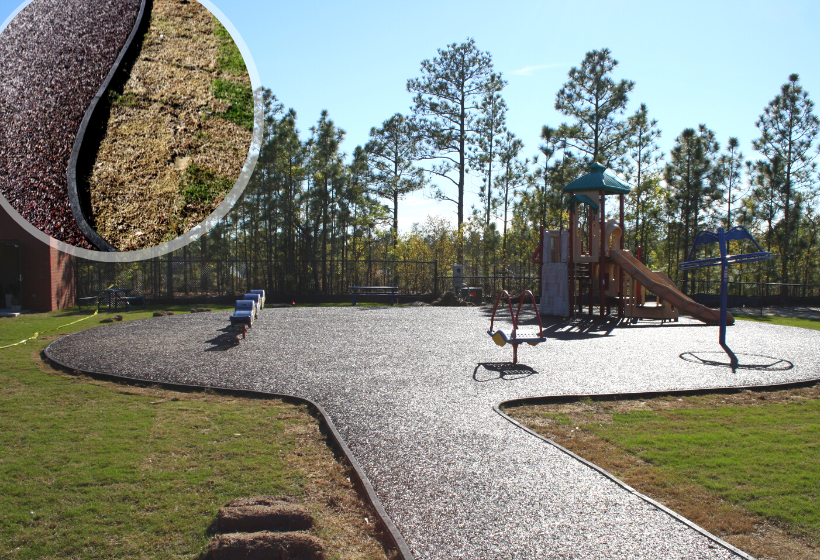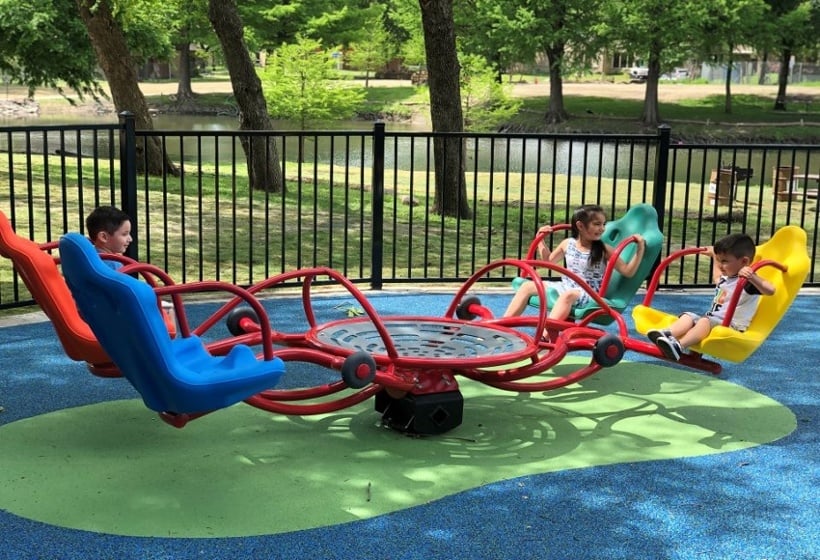Whether it’s administering parks, schools, or any other public areas, they all have one thing in common: doing more with less. A recent NRPA Agency Performance Review found that typical U.S. park and recreation agencies spend nearly $6.5 million annually on operations, with more than half of that going to personnel costs. That leaves them with limited resources for repairs and maintenance.
Failing to install playground borders around your new playground surfacing could potentially add to this financial strain. Rubber curbing helps break the pattern because it’s easy to install, provides strong containment, and requires much lower maintenance. Its flexibility and strength keep play areas safe and open with less intervention and lower overall costs.
Let’s talk about what rubber curbing is, how it’s installed, what it takes to maintain, and why it makes your surfacing last longer.
What is Rubber Curbing for Playgrounds?
Rubber curbing is a flexible, impact-absorbing border made from recycled rubber, typically sourced from post-consumer tires. Its main function is to contain playground surfacing, such as poured-in-place rubber, tiles, bonded, or loose-fill rubber mulch, while providing a smooth, finished edge.
Because rubber curbing is flexible, it easily fits curves and matches the shape of nearby structures. This flexibility means you don’t need special tools or a complicated installation process. Rubber curbing is great for outlining play areas, marking clear pathways, and defining busy spots like swing bays and climbing sections.
Why Low-maintenance Rubber Curbing Matters to Administrators
When your staff are busy or called away for urgent repairs, regular maintenance gets pushed aside. Long repair times or temporary closures can interrupt children’s play, pause school activities, and result in complaints from parents and the community.
As a playground administrator or facility manager, here are the reasons why low-maintenance rubber curbing should be your first choice.
1. Install Rubber Curbing in a Weekend
Most rubber curbing projects need only basic hand tools, such as a hammer, utility knife, shovel, tape measure, level, and rubber mallet. Your crew can complete the work over a weekend or during a school break. This helps you avoid interrupting school sessions, park hours, or special events.
2. Fast Installs on Uneven Ground
Rubber curbing flexes to form curves, adjusts to grade changes, and fits around posts, trees, and existing equipment. This flexibility means fewer cuts and joints, smoother edges, and faster installation.
It works with poured-in-place rubber, tiles, bonded mulch, and loose-fill materials. It helps maintain surfacing depth in high-wear areas such as swing bays and slide exits. You can add ramps or flush entries to create ADA-accessible playground connections to paths and sidewalks.
The layout is easy to modify later. You can reconfigure borders for new equipment, expand play zones, or tighten curves without major rework.
3. Cut Labour Costs with In‑House Installs
Your in-house crews or trained volunteers can complete rubber curbing installations, which minimizes your labour hours and payroll costs. With no concrete forms or curing time, you can reopen play areas sooner. You also save costs on heavy‑equipment rentals, which cuts expenses and makes scheduling easier.
Installation can be phased by zone to keep parts of the playground open during the work. Most repairs are simple and localized, making full closures rare. Durable, low-maintenance rubber curbing withstands shifting and damage, so your team spends less time on repairs.
4. Built to Last in Harsh Weather
Rubber curbing outlasts wood, plastic, and concrete borders. It withstands cracking, chipping, and splintering, and it stays stable through freeze‑thaw cycles. It also:
- Degrades slower than traditional materials when exposed to UV radiation and wet‑dry cycles.
- Doesn’t need staining, sealing, or repainting.
- Stands up to routine contact from mowers, trimmers, and light snow removal.
- Improves edge safety as its tough profile avoids sharp edges and splinters.
Moreover, bevelled or rounded edges lower trip hazards and allow flush entry points, making your park more accessible. Reliable containment preserves surfacing depth in high‑wear zones and provides consistent impact protection over time. The result is fewer closures, fewer repairs, and a longer service life.
5. Reduce Injury Risk with Softer Edges
Rubber curbing uses a soft, impact‑absorbing edge that lowers injury risk compared with hard borders. Its low, bevelled shape minimizes trip hazards and gives smooth, flush transitions for strollers, wheelchairs, and maintenance carts.
It keeps loose‑fill materials at the right depth, particularly in high‑wear areas like swing bays and slide exits. This saves you from raking, sweeping, and material loss onto sidewalks and paths. It also limits scatter and washout during heavy use or rain.
Because it is non‑organic, recycled rubber curbing doesn’t rot, rust, or attract pests. It holds up in long wet seasons and rinses clean, making it a reliable option for sites with moisture and pest pressure.
Implementation Tips for Best Results
To get the most out of your rubber curbing installation, keep these best practices in mind:
- Choose a curb height that matches your surfacing thickness and meets fall-zone requirements.
- Make sure the base is firm and level to keep it from settling.
- Create a good drainage system to keep water from collecting near the edge.
- Secure sections with strong anchors or stakes, particularly at gates, entrances, or on slopes.
- Follow a basic maintenance routine: inspect quarterly, remove debris, check anchors after storms, and re-level areas as needed.
How to Make the Most of Your Playground Investment
Choosing the right edging is important if you want to create a safe, accessible, and low-maintenance playground. Rubber curbing offers durability, flexibility, and long-term value, helping keep play areas open, safe, and cost-effective year after year.
Rubber Designs supplies playground-ready, eco-friendly rubber curbing that fits seamlessly with poured-in-place, tile, bonded rubber mulch, and loose-fill systems. Our team can help you with product selection, technical data, samples, and installation.
Ready to see how rubber curbing can work wonders for your playground? Contact Rubber Designs today for a quote, samples, or expert installation guidance.


.jpg)
